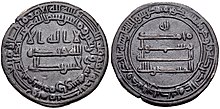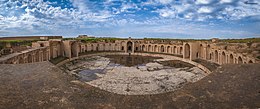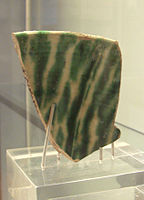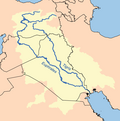Samarra
Samarra
سَامَرَّاء | |
|---|---|
City | |
 The spiral minaret of theGreat Mosque of Samarra(2016) | |
| Coordinates:34°11′54″N43°52′27″E/ 34.19833°N 43.87417°E | |
| Country | |
| Governorate | Saladin Governorate |
| Population (2003 est) | |
| • Total | 348,700 |
| Official name | Samarra Archaeological City |
| Criteria | Cultural: ii, iii, iv |
| Reference | 276 |
| Inscription | 2007 (31stSession) |
| Endangered | 2007- |
| Area | 15,058 ha |
| Buffer zone | 31,414 ha |
Samarra(Arabic:سَامَرَّاء,Sāmarrāʾ) is a city inIraq.It stands on the east bank of theTigrisin theSaladin Governorate,125 kilometers (78 mi) north ofBaghdad.The modern city of Samarra was founded in 836 by theAbbasid caliphal-Mu'tasimas a new administrative capital and military base.[1]In 2003 the city had an estimated population of 348,700.[citation needed]During theIraqi Civil War,Samarra was in the "Sunni Triangle"of resistance.
Thearcheological site of Samarrastill retains much of the historic city's original plan, architecture and artistic relics.[2]In 2007,UNESCOdesignated it aWorld Heritage Site.[3]
History
[edit]This sectionneeds additional citations forverification.(April 2023) |
Prehistoric Samarra
[edit]The remains ofprehistoricSamarra were first excavated between 1911 and 1914 by the German archaeologistErnst Herzfeld.Samarra became thetype sitefor theSamarra culture.Since 1946, the notebooks, letters, unpublished excavation reports and photographs have been in theFreer Gallery of Artin Washington, D.C.
The civilization flourished alongside theUbaid period,as one of the first town states in theNear East.It lasted from 5,500 BCE and eventually collapsed in 3,900 BCE.
Neo-Assyrian period
[edit]A city ofSur-marrati(refounded bySennacheribin 690 BC according to astelein theWalters Art Museum) is insecurely identified with a fortifiedAssyriansite at al-Huwaysh on the Tigris opposite modern Samarra. The State Archives of Assyria Online identifiesSurimarratas the modern site of Samarra.[4]
Ancient place names for Samarra noted by the Samarra Archaeological Survey are GreekSouma(PtolemyV.19,ZosimusIII, 30), LatinSumere,a fort mentioned during theretreat of the army of Julianin 363 AD (Ammianus MarcellinusXXV, 6, 4), and SyriacSumra(Hoffmann,Auszüge,188;Michael the Syrian,III, 88), described as a village.
The possibility of a larger population was offered by the opening of the Qatul al-Kisrawi, the northern extension of theNahrawan Canalwhich drew water from theTigrisin the region of Samarra, attributed byYaqut al-Hamawi(Muʿjam,see under "Qatul" ) toKhosrau I(531–578). To celebrate the completion of this project, a commemorative tower (modern Burj al-Qa'im) was built at the southern inlet south of Samarra, and a palace with a "paradise" or walled hunting park was constructed at the northern inlet (modern Nahr ar-Rasasi) nearad-Dawr.A supplementary canal, the Qatul Abi al-Jund, excavated by theAbbasid CaliphHarun al-Rashid,was commemorated by a planned city laid out in the form of a regular octagon (modern Husn al-Qadisiyya), called al-Mubarak and abandoned unfinished in 796.
-
Female statuette, Samarra, 6000 BC
-
The Samarra bowl at theVorderasiatisches Museum,Berlin. Theswastikain the center of the design is a reconstruction.[5]
-
Chinese-madesancaipottery shard, 9th–10th century, found in Samarra, an example ofChinese influences on Islamic pottery.British Museum.
Abbasid capital
[edit]
In 836CE,theAbbasidCaliphAl-Mu'tasimfounded a new capital at the banks of the Tigris. Here he built extensive palace complexes surrounded by garrison settlements for his guards, mostly drawn fromCentral AsiaandIran(most famously theTurks,as well as the KhurasaniIshtakhaniyya,FaraghinaandUshrusaniyyaregiments) or North Africa (like theMaghariba). Although quite often calledMamlukslave soldiers, their status was quite elevated; some of their commanders bore Sogdian titles of nobility.[6]

The city was further developed under Caliphal-Mutawakkil,who sponsored the construction of lavish palace complexes, such as al-Mutawakkiliyya, and theGreat Mosque of Samarrawith its famous spiralminaretor Malwiya, built in 847. For his sonal-Mu'tazzhe built the large palace Bulkuwara.

The Nestorian patriarchSargis(860–72) moved the patriarchal seat of theChurch of the Eastfrom Baghdad to Samarra, and one or two of his immediate successors may also have sat in Samarra so as to be close to the seat of power.[8]
Samarra remained the residence of the caliph until 892, whenal-Mu'tadidreturned the capital to Baghdad.[9]Historical sources report that the city was looted around this time. Its population probably decreased and the city declined, but it remained an important market center.[9]
From the tenth century onward it turned into an important pilgrimage site. During the 12th and 13th centuries, the river's course to the south of the city shifted further east. As a result, the main road between Baghdad and Mosul was moved to the west bank and Samarra lost its importance as a trading town.[9]
Modern era
[edit]In the eighteenth century, one of the most violent battles of the 1730–1735Ottoman–Persian War,theBattle of Samarra,took place, where over 50,000 Turks and Persians became casualties. The engagement decided the fate ofOttoman Iraqand kept it under Istanbul's suzerainty until theFirst World War.
During the 1950s, Samarra gained new importance when a permanent lake,Lake Tharthar,was created through the construction of theSamarra Barrage,which was built in order to prevent the frequent flooding of Baghdad. Many local people were displaced by the dam, resulting in an increase in Samarra's population.[10]

Samarra is a key city in Saladin Governorate, a major part of the so-calledSunni Trianglewhere insurgents were active during theIraq War.[11]Though Samarra is famous for its Shi'i holy sites, including the tombs of several Shi'i Imams, the town was traditionally and until very recently, dominated bySunniArabs.Tensions arose between Sunnis and the Shi'a during the Iraq War. On February 22, 2006, the golden dome of theal-Askari MosquewasbombedbyAl-Qaeda in Iraq,setting off a period of rioting and reprisal attacks across the country which claimed hundreds of lives. No organization claimed responsibility for the bombing. On June 13, 2007, Sunni insurgentsattacked the mosqueagain and destroyed the twominaretsthat flanked the dome's ruins.[12]On July 12, 2007, the clock tower was blown up. No fatalities were reported. Shiʿi clericMuqtada al-Sadrcalled for peaceful demonstrations and three days of mourning.[13]He stated that he believed no Sunni Arab could have been behind the attack, though according to theNew York Timesthe attackers were likely Sunnis linked toAl-Qaeda.[14]The mosque compound was closed after the 2006 bombing and a indefinite curfew was placed on the city by the Iraqi police at the time.[15][16]In 2009, the mosque reopened while restoration was ongoing.[17]
Ever since the end of Iraqi civil war in 2007, the Shia population of the holy city has increased exponentially. However, violence has continued, with bombings taking place in2011and2013.In June 2014, the city was attacked by theIslamic State of Iraq and the Levant(ISIL) as part of theNorthern Iraq offensive.ISIL forces captured the municipality building and university, but were later repulsed by theIraqi armyand SWAT forces.[18]The nearbyImam Dur Mausoleum,a historic mausoleum dedicated toMuslim ibn Quraysh,a Shi'i ruler, was destroyed by ISIL in 2014.[19]
Geography
[edit]Climate
[edit]Samarra has ahot desert climate(Köppen climate classificationBWh). Most rain falls in the winter. The average annual temperature in Samarra is 22.7 °C (72.9 °F). About 171 mm (6.73 in) of precipitation falls annually.
| Climate data for Samarra | |||||||||||||
|---|---|---|---|---|---|---|---|---|---|---|---|---|---|
| Month | Jan | Feb | Mar | Apr | May | Jun | Jul | Aug | Sep | Oct | Nov | Dec | Year |
| Mean daily maximum °C (°F) | 15.3 (59.5) |
18.0 (64.4) |
22.1 (71.8) |
28.3 (82.9) |
35.7 (96.3) |
41.1 (106.0) |
43.9 (111.0) |
43.6 (110.5) |
39.7 (103.5) |
33.2 (91.8) |
24.4 (75.9) |
17.4 (63.3) |
30.2 (86.4) |
| Mean daily minimum °C (°F) | 4.4 (39.9) |
5.9 (42.6) |
9.3 (48.7) |
14.2 (57.6) |
19.6 (67.3) |
23.5 (74.3) |
25.9 (78.6) |
25.4 (77.7) |
21.4 (70.5) |
16.4 (61.5) |
10.6 (51.1) |
5.8 (42.4) |
15.2 (59.4) |
| Averageprecipitationmm (inches) | 25 (1.0) |
30 (1.2) |
29 (1.1) |
21 (0.8) |
8 (0.3) |
0 (0) |
0 (0) |
0 (0) |
0 (0) |
4 (0.2) |
20 (0.8) |
34 (1.3) |
127 (5.0) |
| Source:climate-data | |||||||||||||
Religious significance
[edit]The city is also home toal-Askari Shrine,containing the mausolea of theImamsAli al-HadiandHasan al-Askari,the tenth and eleventhShiʿi Imams,respectively, as well as the place from whereMuhammad al-Mahdi,known as the "Hidden Imam", reportedly went intoThe Occultationin the belief of theTwelverorShias.This has made it an important pilgrimage centre for the Imami Shias.[20]In addition, Hakimah andNarjis,female relatives of the ProphetMuhammadand the Imams, held in high esteem by Muslims, are buried there, making this mosque one of the most significant sites of worship.[20]
Sports
[edit]Samarra is home to theSamarra SC,that play in the second highest division of the Iraqi football league system, namelyIraqi Premier Division League.Its ground is theSamarra Stadium.
In popular culture
[edit]The metaphor of "Having an appointment in Samarra", signifying death, is a literary reference to an ancient Babylonian myth recorded in theBabylonian Talmudand transcribed byW. Somerset Maugham,[21]in which Death narrates a man's futile attempt to escape him by fleeing from Baghdad to Samarra. The story "The Appointment in Samarra" subsequently formed the germ of anovel of the same namebyJohn O'Hara.[22]
In the 1968 filmTargets,Byron Orlok, an aging horror film star played byBoris Karloff,tells Maugham's version of the story to his younger colleagues.[23]
The story is told in "The Six Thatchers",a 2017 episode ofSherlock.
See also
[edit]References
[edit]- ^Northedge, Alastair E. (2012). "ʿAbbāsid art and architecture". In Fleet, Kate; Krämer, Gudrun; Matringe, Denis; Nawas, John; Rowson, Everett (eds.).Encyclopaedia of Islam, Three.Brill.ISBN9789004161658.
- ^"Samarra Archaeological City".UNESCO World Heritage Centre.Retrieved2023-04-24.
- ^"Unesco names World Heritage sites".BBC News.2007-06-28.Retrieved2010-05-23.
- ^SAAO
- ^Stanley A. Freed, "Research Pitfalls as a Result of the Restoration of Museum Specimens",Annals of the New York Academy of Sciences,Volume 376, The Research Potential of Anthropological Museum Collections, pages 229–245, December 1981.doi:10.1111/j.1749-6632.1981.tb28170.x.
- ^Babaie, Sussan (2004).Slaves of the Shah.New York: I.B.Tauris & Co Ltd. pp.4–5.ISBN1-86064-721-9.
- ^Blair, Sheila S.; Bloom, Jonathan M. (1995)."Samarra".The Art and Architecture of Islam 1250-1800.Yale University Press.ISBN9780300064650.
- ^Mari, 80–1 (Arabic), 71–2 (Latin)
- ^abcNorthedge, Alastair (1995)."Sāmarrā'".InBosworth, C. E.;van Donzel, E.;Heinrichs, W. P.&Lecomte, G.(eds.).The Encyclopaedia of Islam, Second Edition.Volume VIII: Ned–Sam.Leiden: E. J. Brill. pp. 1039–1041.ISBN978-90-04-09834-3.
- ^Hann, Geoff; Dabrowska, Karen; Townsend-Greaves, Tina (2015-08-07).Iraq: The ancient sites and Iraqi Kurdistan.Bradt Travel Guides.ISBN978-1-84162-488-4.
- ^Bazzaz, Sahar (2013)."The Discursive Mapping of Sectarianism in Iraq: The" Sunni Triangle "in the Pages of The New York Times".In Bazzaz, Sahar; Batsaki, Yota; Angelov, Dimiter (eds.).Imperial Geographies in Byzantine and Ottoman Space.Hellenic Studies Series. Washington, DC: Center for Hellenic Studies.
- ^Thomas E. Ricks (6 January 2010).The Gamble: General Petraeus and the American Military Adventure in Iraq.Penguin Publishing Group. p. 228.ISBN978-1-101-19206-1.
- ^"Explosion Topples Minarets At Iraqi Shi'ite Shrine".RadioFreeEurope/RadioLiberty.2007-06-13.Retrieved2015-08-22.
- ^John F. Burns; Jon Elsen (2007-06-14)."Several Mosques Attacked, but Iraq Is Mostly Calm - New York Times".The New York Times.Retrieved2015-08-22.
- ^Qassim Abdul-Zahra (June 13, 2007)."Iraqi police say famous shrine attacked".Associated Press.
- ^"Blast hits key Iraq Shia shrine".BBC. 2007-06-13.Retrieved2012-04-21.
- ^Chulov, Martin (2009-04-16)."Bombed Iraq shrine reopens to visitors".The Guardian.ISSN0261-3077.Retrieved2023-09-26.
- ^Hassan, Ghazwan (5 June 2014)."Iraq dislodges insurgents from city of Samarra with airstrikes".Reuters.Retrieved27 June2014.
- ^"Archnet > Site > Qubba Imam al-Dur".archnet.org.Retrieved2023-04-14.
- ^abPanjwani, Imranali, ed. (2012).The Shi'a of Samarra: The Heritage and Politics of a Community in Iraq.Bloomsbury Publishing.ISBN978-1-78672-982-8.
- ^"The Appointment in Samarra" (as retold by W. Somerset Maugham [1933]).
- ^John O'Hara,Appointment in Samarra,Harcourt, Brace & Co.,. L., "The Destined Hour" inFrom Many Times and Lands(London, 1953); reprinted inEvery Poem Tells a Story: A Collection of Stories in Verse,ed. Raymond Wilson (London, 1988;ISBN0-670-82086-5/ 0-670-82086-5).
- ^Bogdanovich, Peter (director) (1968).Targets(DVD). United States of America: Criterion.
Selected bibliography
[edit]- De la Vaissière, Étienne (2007):Samarcande et Samarra. Élites d’Asie central dans l’empire abbaside(Studia Iranica, Cahier 35), Paris.
- Gordon, Matthew S. (2001).The Breaking of a Thousand Swords: A History of the Turkish Military of Samarra (A.H. 200–275/815–889 C.E.).Albany, New York: State University of New York Press.ISBN0-7914-4795-2.
- Northedge, Alastair (2005):The historical topography of Samarra,London.
- Robinson, Chase (ed.) (2001):A Medieval Islamic City Reconsidered: An Interdisciplinary Approach to Samarra(Oxford Studies in Islamic Art 14). Oxford.
External links
[edit]- Ernst Herzfeld Papers, Series 7: Records of Samarra Expeditions, 1906–1945Smithsonian Institution, Freer Gallery of Art and Arthur M. Sackler Gallery Archives, Washington, D.C.
- Ernst Herzfeld Papers, Series 7: Records of Samarra Expeditions, 1906–1945[permanent dead link]Collections Search Center, S.I.R.I.S., Smithsonian Institution, Washington, D.C.
- Iraq Image - Samarra Satellite Observation
- Samarra Archaeological Survey
- "The Appointment in Samarra"
- Destruction of Askari Mosque
- Samarra on Google Earth
- Samarra
- Arabic architecture
- Archaeological sites in Iraq
- Archaeological type sites
- Capitals of caliphates
- Cities in Iraq
- District capitals of Iraq
- Holy cities
- Populated places in Saladin Governorate
- Populated places on the Tigris River
- Samarra culture
- Shia holy cities
- World Heritage Sites in Danger
- World Heritage Sites in Iraq



![The Samarra bowl at the Vorderasiatisches Museum, Berlin. The swastika in the center of the design is a reconstruction.[5]](https://upload.wikimedia.org/wikipedia/commons/thumb/1/1d/Samarra_bowl.jpg/197px-Samarra_bowl.jpg)



